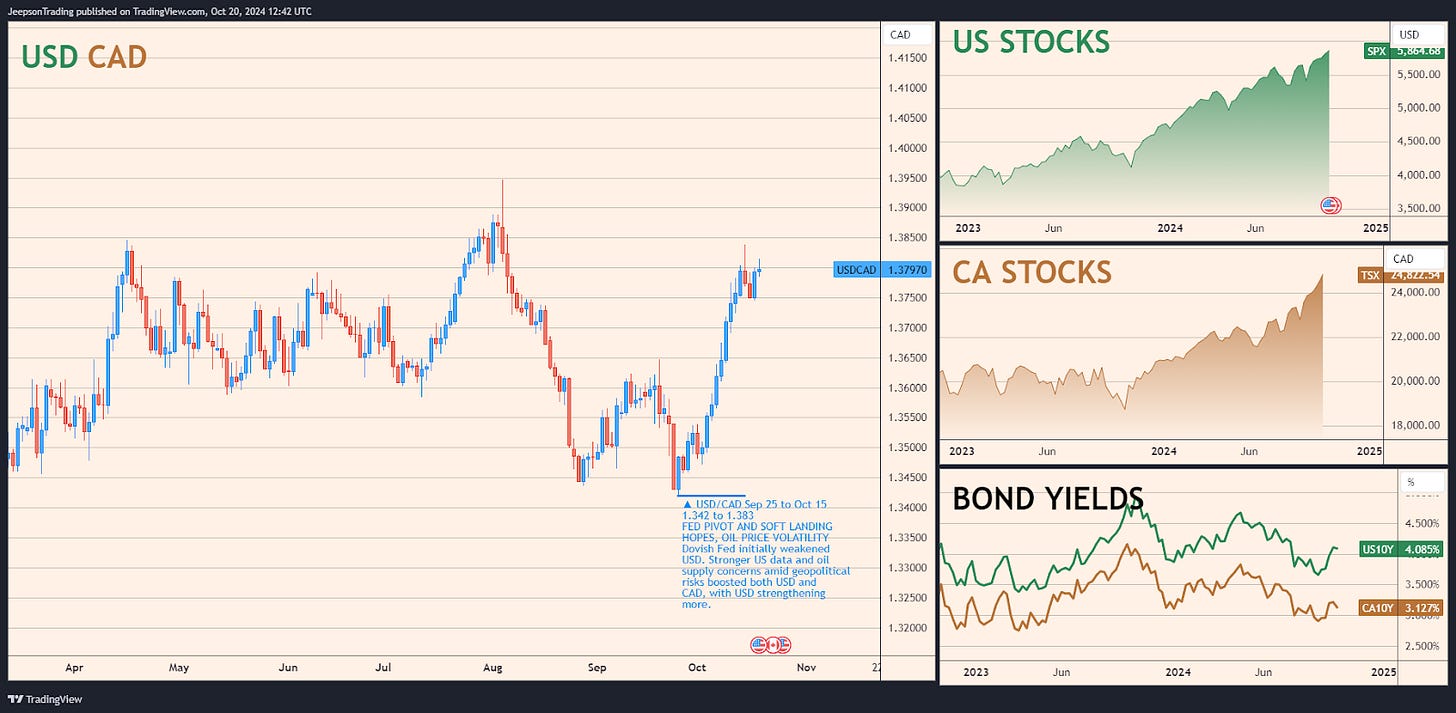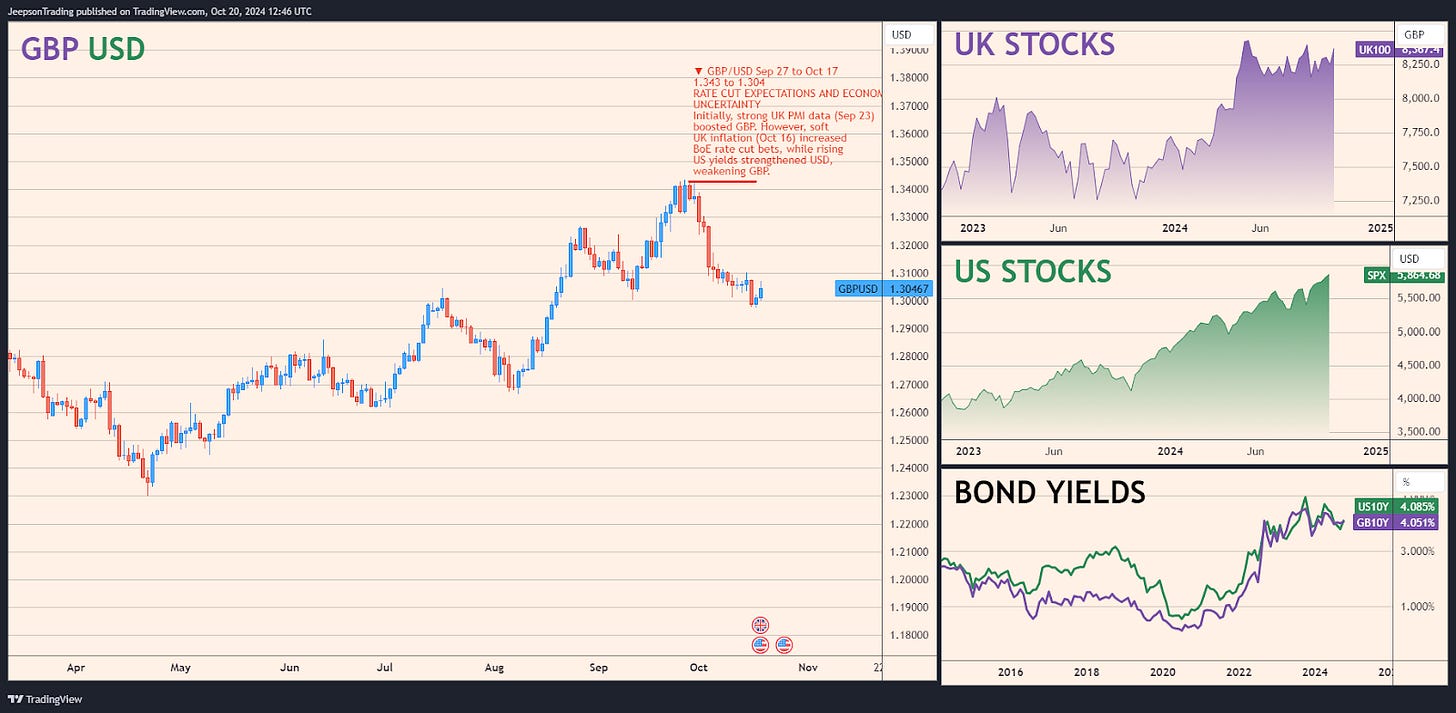Political Events Add to the Uncertainty
Monday, October 21, 2024 (Week 43)
Forex markets face a complex confluence of factors. The looming US Presidential election weighs on the USD. Meanwhile, persistent core inflation in the US fuels debate about the Fed's next move. Uncertainty surrounding the UK's Autumn Budget adds to market volatility. These narratives have driven sentiment and influenced major currency pairs over recent weeks.
USD/CAD: Loonie Eyes US Election and Oil's Uncertain Path
Traded actively by banks, hedge funds, and institutional investors, USD/CAD boasts high liquidity. The pair often has an inverse relationship with oil prices. Movements in the US and Canadian stock markets can also exert influence. The October 15th COT report shows asset managers holding a net short position in CAD.
Dominant Market Theme: Fed Pivot vs. TSX Strength
The USD/CAD narrative is being shaped by the contrasting outlooks for the US and Canadian economies. In the US, the focus is on the Fed's potential shift to easing and soft-landing hopes amid moderating inflation. However, persistent core inflation and election uncertainty add volatility. Conversely, the TSX's record highs boost Canadian sentiment, although anxieties persist about the BoC’s policy direction, given mixed Canadian data.
Upside Thesis (Low Conviction): Positive surprises in upcoming US data could strengthen the USD and lift USD/CAD. Stronger existing home sales (October 23rd) or flash PMIs (October 24th) could trigger this move. However, this is unlikely to be sustained throughout the upcoming month due to election jitters and potential risk aversion.
Downside Thesis (Medium Conviction): Hawkish BoC signals or positive Canadian economic surprises could push USD/CAD lower. Strong retail sales (October 25th) or hawkish BoC commentary could boost CAD. This scenario has moderate potential to continue into the upcoming month, fueled by ongoing TSX strength and a potentially less dovish BoC.
What to Watch:
USD: Existing Home Sales (Wed, Oct 23rd, Week 43), Initial Jobless Claims (Thurs, Oct 24th, Week 43), Durable Goods Orders (Fri, Oct 25th, Week 43)
CAD: BoC Interest Rate Decision (Wed, Oct 23rd, Week 43), New Housing Price Index MoM (Thurs, Oct 24th, Week 43), Retail Sales MoM (Fri, Oct 25th, Week 43)
GBPUSD: Sterling Awaits Autumn Budget Judgment
GBPUSD, actively traded by institutional and leveraged funds, is highly liquid thanks to London's financial importance. GBP often correlates with risk sentiment and UK gilt yields. Rising yields often support GBP. The October 15th COT report reveals leveraged funds are net long GBP.
Dominant Market Theme: Autumn Budget Uncertainty
The UK's Autumn Budget (October 30th) is the dominant theme for GBPUSD, creating considerable uncertainty. Fears of tax hikes and spending cuts weigh on GBP. Recent positive UK data, like September's robust Construction PMI (S&P Global), has been overshadowed by these concerns.
Upside Thesis (Low Conviction): A positive market reaction to the Autumn Budget could lift GBPUSD. A surprisingly hawkish BoE could further strengthen GBP. This scenario is less likely in the near term due to global growth concerns and a dovish Fed.
Downside Thesis (Medium Conviction): A disappointing budget could spark a GBP selloff and push GBPUSD lower. Weak UK data, such as soft retail sales or declining consumer confidence, would exacerbate GBP’s decline.
What to Watch:
GBP: S&P Global Composite PMI Flash (Thurs, Oct 24th, Week 43), CBI Industrial Trends Orders (Wed, Oct 23rd, Week 43), GfK Consumer Confidence (Fri, Oct 25th, Week 43)
USD: Existing Home Sales (Wed, Oct 23rd, Week 43), Initial Jobless Claims (Thurs, Oct 24th, Week 43), Durable Goods Orders (Fri, Oct 25th, Week 43)
EURUSD: Euro's Economic Tightrope
EURUSD, a highly liquid pair, is popular amongst all types of traders. Its liquidity is driven by the economic weight of the Eurozone and the US. EURUSD serves as a risk barometer, often weakening during risk-off periods. The October 15th COT report shows asset managers reducing their net short EUR positions.
Dominant Market Theme: ECB Easing and Growth Fears
EURUSD is influenced by expectations of further ECB easing and concerns about the Euro Area's economic outlook. Weaker-than-expected September PMI data added to these anxieties (S&P Global). The ECB's October rate cut to 3.4%, alongside its dovish guidance, pressured EUR. Further signs of Eurozone economic weakness, particularly in Germany, could accelerate the euro's decline.
Upside Thesis (Low Conviction): A positive surprise in the October flash PMIs (Thursday, October 24th, Week 43) could hint at resilience in the Euro Area economy, potentially lifting EURUSD. A more hawkish ECB would add further support. However, global anxieties could limit EUR gains, especially with the looming Q3 Euro Area GDP release on October 30th.
Downside Thesis (Medium Conviction): Disappointing flash PMIs could reinforce growth concerns, increasing the likelihood of further ECB easing and pressuring EURUSD. The direction of this trend hinges on the Q3 GDP data (Wednesday, October 30th, Week 43).
What to Watch:
EUR: HCOB Composite PMI Flash (Thurs, Oct 24th, Week 43), Consumer Confidence Flash (Wed, Oct 23rd, Week 43), GDP Growth Rate QoQ Flash (Wed, Oct 30th, Week 43)
USD: Existing Home Sales (Wed, Oct 23rd, Week 43), Initial Jobless Claims (Thurs, Oct 24th, Week 43), Durable Goods Orders (Fri, Oct 25th, Week 43)
Conclusion: Forex Outlook: Navigating Election, Budget, and Growth Risks
USD/CAD faces a tug-of-war between a potential Fed pivot and TSX strength. GBPUSD awaits the UK Autumn Budget verdict, while EURUSD grapples with Eurozone growth fears and ECB dovishness. Sentiment is cautious, given upcoming data releases and political events. The US election and UK budget are major wildcards.
Key Action Points:
Risk Management: Implement robust risk management strategies to navigate uncertainty.
Data Focus: Pay close attention to key economic indicators for clues about central bank policy paths.
Political Awareness: Monitor political events, especially the US election and the UK budget, for potential market impact.
Sources:
Bank of Canada
Statistics Canada
Bank of England
Office for National Statistics
European Central Bank
EUROSTAT
Federal Reserve
U.S. Bureau of Labor Statistics
U.S. Department of Labor
U.S. Bureau of Economic Analysis
U.S. Treasury
Institute for Supply Management
University of Michigan
NFIB
Trading Economics
S&P Global
Bloomberg
Reuters





